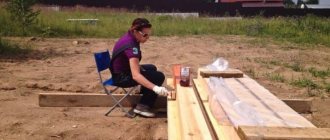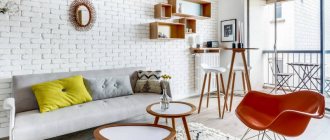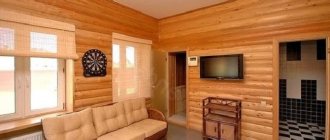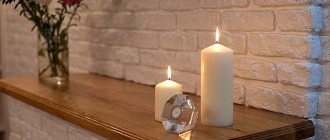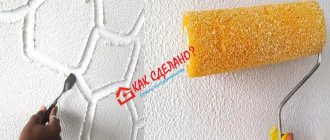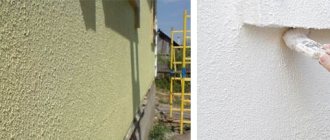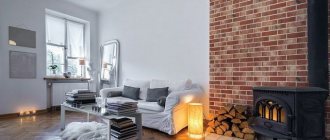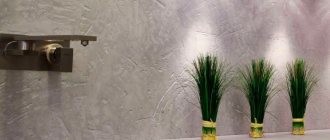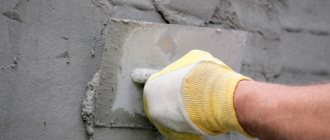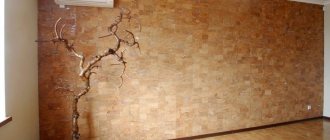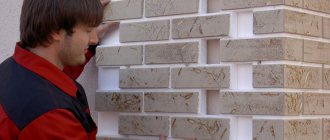It is human nature to want to make production waste-free. The block house seems to have started like this - with the use of slabs left over from sawing rounded logs as cladding material for the exterior and interior decoration of frame houses. As sales volumes grew, manufacturers switched from using slabs as a by-product to producing panels that imitate logs from boards using the milling method.
What to paint with?
Wood is an aesthetically attractive material, but susceptible to various influences.
It can be damaged by moisture, temperature changes in winter, ultraviolet rays and insects. Block house elements made from natural raw materials are no exception. Impregnations and protective paint coatings will help extend the service life of a wooden facade. A more expensive version of the block house undergoes industrial processing in autoclaves. The coating elements are impregnated with compounds that protect the wood from fire, rotting and the destructive effects of other factors. Those who bought untreated parts should improve their properties themselves. This must be done before installation. It is advisable to process both the planks, the sheathing, and the base. Impregnations and stains are suitable for this.
Impregnations do not change the appearance of wood. All compositions can be divided into three groups:
- Acrylic water soluble ones are used for untreated wood. Good for interior decoration, as they do not have an unpleasant odor.
- Alkyd ones are made on the basis of white spirit and alkyd resins. They create a durable coating, but have a serious drawback - a pungent odor. Used only for facade work.
- Oilseeds are made from natural oils, most often linseed. The coating takes a long time to absorb and dry, but is durable. But it is incompatible with some paints.
Stains change the shade of wood towards darker tones. At the same time, they do not form a smooth layer or film on the surface. There are also colorless ones; they perform only protective functions. Compositions are produced on a water basis, as well as on the basis of alcohol, solvents and wax.
Decorative coating can emphasize the natural structure of the tree or change it in accordance with the owners' plans. In the first case, you should choose a transparent varnish or azure. If the surface of the parts is imperfect, paint will help hide some imperfections.
For decorative finishing of a block house, you can use materials, taking into account their characteristics.
Varnishes create a transparent or translucent film on the surface. Azures have the protective properties of impregnations and at the same time create a thin waterproof layer on the surface. They come in glossy and matte, transparent and tinted. Alkyd-urethane glazes make wood more resistant to mechanical damage. Paints - glossy, matte and semi-matte. For exterior finishing, it is better to choose oil rather than water-based finish. Wax – traditional finish with a matte sheen
It is important to remember that you can no longer apply varnish or paint on top of it.
Before painting the wall of a house covered with a block house, it is cleaned of dust or old coating. It is advisable to paint new parts before installation. Before applying paint, the wood is treated with a primer. It will improve the adhesion of the enamel to the surface. To work over a large area, craftsmen advise using a roller and painting hard-to-reach areas with a brush.
Options for wall decoration in a wooden house
There are many options for finishing a wooden house. It all depends on the operating conditions, finances, your desires and the style of the room.
Clean log house finished with paints and varnishes
If you strive for naturalness and environmental friendliness, and live in a region with a consistently dry and stable climate, then a log house made of natural wood is suitable for you.
In such a house you will always be haunted by the aroma of natural wood.
This type of finishing is increasingly gaining popularity among our stars. This original Russian style makes the room lively and the microclimate healthy. This type of finishing attracts with its beauty, durability, environmental friendliness, simple design and simplicity. Such projects can be recreated with historical accuracy in the way houses were built many centuries ago.
Lining as a wood finish for walls when it is impossible to sand the timber
Lining is a traditional material for home decoration. Its advantages are obvious - it is easy to install and looks quite aesthetically pleasing. The lamellas, with the help of special fasteners, are connected tightly.
Cladding with clapboard creates a perfectly smooth and beautiful surface
Other advantages of this material include:
- speed of installation;
- environmental friendliness;
- many shades of coating;
- made from different types of wood.
Among the disadvantages are:
- high price;
- the need to construct sheathing;
- the need for careful care.
Preparatory steps include not only the installation of the sheathing, but also the processing and inspection of the lamellas themselves
It is important to sand and dry them first.
The final stage is coating the lining with varnish, sanding and another varnishing.
Block house is a more modern type of lining. Typically, such blocks are made from high quality wood, which does not shrink, is not inferior in strength and strength, and in many ways even surpasses classical materials.
The block house allows you to maintain the unique microclimate of the roomIn addition, this finishing material does not lose its original quality due to wood processing. The texture of the material is no different from natural wood.
The main advantages of a block house:
- mechanical strength;
- environmental friendliness;
- aesthetic appearance;
- light weight;
- ease of assembly.
For interior decoration, slats with a thickness of no more than 25 mm are better suited. As the thickness increases, difficulties may arise with high-quality fastening of the sheathing. In addition, this can lead to a reduction in the internal space of the room, which is extremely undesirable. The disadvantages of the material include too low vapor permeability and increased flammability.
If you purchase material in winter, it is important to place it in a warm room to dry it
Finishing a wooden house inside with plasterboard
Drywall is the ideal solution for those cases when you need to hide or hide something. This could be some kind of communications, or planning defects. Typically, drywall is used to level walls. Most often, in a wooden house, plasterboard is used to finish ceilings or erect interior partitions. In addition, such coatings will be a good solution for bathrooms.
Drywall with a moisture-resistant coating can protect your bathtub walls from excess moisture
In addition, plasterboard is made in a fire-resistant version. This is exactly the case when it can be used to cover fireplaces or stoves, additionally protecting wooden walls from overheating and fire.
For wooden houses, timber sheathing is used as a base for drywall
Wall panels of various types
Wall panels for finishing a wooden house are quite a popular option. The choice of materials is quite large. The finish with natural veneer, as well as with laminated MDF, which is not afraid of moisture and can replicate almost any texture, looks very interesting.
MDF boards can imitate patterns not only of wood, but also of leather, bamboo, and plaster
What are the benefits of wall panels:
- simple and easy installation;
- good heat and sound insulation;
- stylish appearance.
The panels are also convenient because they can be selected to suit any size. They are also attached to the sheathing and have a tongue and groove fastening system. Externally, the seams are almost invisible. The coating looks like a single monolith.
Decoration with MDF boards can be selected to suit any interior
Related article:
Facade surface preparation
Preliminary preparation is the most important stage of work, the thoroughness of which determines the durability and quality of service of the wall pie and cladding.
Procedure:
- Removal of all foreign objects, dismantling of air conditioners, drains, brackets, etc.
- Inspection and detection of all existing deficiencies.
- Removing old paint, peeling or crumbling areas . The surface must be completely monolithic and durable, all weak areas must be removed as much as possible.
- Filling potholes or dents caused by removing problem areas . Putty is used. If there are a large number of dents or their depth, continuous plastering of the surface is recommended.
- The last stage of the preparatory work is to apply a double layer of primer with intermediate drying according to the user instructions.
NOTE!
Under no circumstances should preparatory work be neglected. The condition of the walls should be as close to ideal as possible. After installation of the sheathing, there will be no access, control or change of the condition of the walls. All possible actions should be carried out in advance.
Installation of sheathing
Assembling the puzzle inside the house begins with a frame made of beams. Both the primer for plaster and the blockhouse require preliminary installation in the form of lathing, otherwise the final result may be distorted over time. It is unlikely that anyone will want to live in a kingdom of crooked walls.
Detailed blockhouse installation diagram
This manipulation during installation often involves attaching beams with a diameter of 0.20 - 0.30 cm to the base. One of the simplest methods of fixation is universal self-tapping screws; nails can also be useful.
- Horizontal or vertical? When the house block is in a horizontal position, the sheathing bars are attached vertically, and vice versa. If necessary, the board must be adjusted to the required thickness. If you don’t have woodworking skills, you can put something under it (to make it bigger). Careful preparation of the sheathing will give you the opportunity to get a perfectly smooth wall.
- The saving level will control surface differences of 5 plus.
- Between the boards there are special compounds to retain the heat of the vapor barrier.
Blockhouse installation technology
How to join panels at external and internal corners
Docking the corner connections of a block house can be done in different ways:
- No special actions are performed; the corner connection is made by installing the appropriate profile additional element .
- A planed square beam is installed along the axis of the angle, into which the ends of the panels rest . The option is good, but you will need to accurately calculate the thickness of the timber and the length of the panels to make the connection as tight as possible.
- The panels are cut at 45°; after installation, the panels corresponding to each other on different sides of the corner are connected with self-tapping screws . To do this, in one panel you need to drill a blind hole at an angle into which the screw head will go. This way the panels will be attracted to each other, creating a tight and neat connection. The holes should subsequently be plugged with plugs and sanded flush.
- The most difficult option is that the corners of the panels are sawn at 45° and precisely adjusted to each other without connecting to each other.
Material selection
Decorative finishing should begin with the selection of materials. The block house is divided into several types depending on the type of wood and class of material.
Wood type
Block house slats can be made from several types of wood, differing from each other in texture, color, technical properties and cost.
The table shows the comparative hardness of some types of wood used for interior decoration.
Use coniferous wood for residential premises
For residential premises - living rooms and bedrooms, it is recommended to use coniferous wood. The subtle pine smell that will emanate from the walls and ceilings will have a calming effect on the nervous system of the inhabitants of the house.
In addition, the resin of coniferous trees has antiseptic properties, preventing the development of pathogenic bacteria in the room.
For cladding interior spaces with high heating temperatures (saunas, baths), it is recommended to use deciduous wood, since coniferous wood varieties tend to release excess resin when heated.
For finishing a bath, it would be optimal to use larch
You should also take into account such a factor as high humidity, so decorating the walls of a block house in such rooms involves the use of wood that is resistant to dampness.
At the same time, an important criterion for choosing the type of wood is personal preference. After all, the main purpose of decorating a wall with a block house is to create an interior that is pleasing to the eye, so if you like the openwork texture of Karelian birch or beech, purchase just such a material.
Panel size
Use thin panels to decorate rooms
When choosing panels, you should also pay attention to their size. Typically, the width of the lamellas ranges from 80 to 230 mm, but there may be exceptions to these rules
Wider panels are used to decorate the facades of buildings, since inside the house they will look too massive, creating an oppressive feeling and “eating up” the space.
As practice shows, for interior decoration it is better to take thin lamellas, 8–16 cm wide. The thickness of the lamella can be from 20 to 50 mm. The length of the block house slats can vary from 2 to 6 m, so when choosing a material, this parameter should also be taken into account so that there is as little production waste as possible.
Material class
Extra-class materials have a high price
In addition to the type of wood and size, the block house is also divided into classes depending on its quality.
It has enhanced decorative qualities; first of all, it is characterized by the almost complete absence of knots and other cosmetic defects. However, the cost of such a block house is quite high.
The next class of material is “A” and “B”. They have a larger number of knots, and some other defects are acceptable on their surface.
The cost of such material, accordingly, is significantly lower than that of the extra class, but if you are not too demanding of quality, then you should pay attention to this economy class option. Moreover, repairing small chips or dents is not difficult
Wood used
In Russia, most logging is done from conifers: pine and spruce. Undoubtedly, a block house made of pine has more advantages than a spruce one. If you choose between spruce and pine, you need to choose pine.
A pine and spruce block house is not suitable for baths and saunas, as it will release resin and dark spots may appear. Siberian larch is ideal for a bathhouse.
Some elite varieties of larch, oak, birch and other trees are also sold in stores. This block house is often made to order and used as additional decor. A block house made of pine needles is very suitable in terms of price-quality ratio.
Basement siding
Basement siding is used to finish a building in the base area. This cladding is made to protect the lower part of the house from the aggressive effects of precipitation and constantly operating mechanical factors.
Finishing the base with siding
To eliminate their harmful effects, cladding should be used, the thickness of which should exceed 3 millimeters. To solve such problems, installation of basement siding is used.
Basement siding
Individual elements of the building material have a relatively large thickness and are made in small sizes in order to ensure reliable fastening and reduce the likelihood of spontaneous destruction of the structure due to its large weight, which does not correspond to the fastening method used.
Attaching basement siding
To give a house a presentable appearance, they often use basement siding, which will not only provide reliable protection for the lower part of the building, but will also play an effective decorative role.
Basement siding also plays a decorative role
In accordance with the requirements of the owner of the building, you can select elements of basement siding that imitate various materials: wood, brick, stone. To ensure an affordable level of cost of building materials intended for the construction of a basement structure, manufacturers often combine it with affordable raw materials.
Basement siding imitating brick
In some cases, cement siding is used to cover the lower part of the building. It should be taken into account that in order to perform the functions assigned to the structure, its height should not be lower than 15 centimeters from ground level.
Finishing the base with cement siding
The advantages of basement siding lie in the possibility of its long-term use, the period of which practically corresponds to the life of a residential building, during which it will not be necessary to carry out work to eliminate damage caused by mechanical force or natural adverse factors.
In a house whose cladding is made in the style of basement siding, rodents cannot appear, due to the reliable protection of all walls from the possible entry of uninvited guests. The construction material does not crack and maintains a respectable appearance for a long period of time.
Basement siding has a long service life
When purchasing siding elements made from various materials, you should consider:
- thickness of the structural element;
- presence of defects on the surface;
- availability of certificates of product compliance with regulatory requirements;
- manufacturer's warranty.
In general, buyers prefer to equip their homes with cladding made from natural materials, due to their environmental friendliness and hypoallergenicity.
Types of basement siding
When choosing elements for a future structure, materials whose appearance imitates natural wood or stones are popular. Wooden siding is less popular in building cladding due to its high price and short-lived product life.
Basement wood siding
All types of siding can be easily washed when dirty. For convenience, a garden hose is used for such purposes, under the pressure of water from which any dirt can be easily removed with a sponge.
Siding needs regular washing and cleaning.
Clinker thermal panels
The main advantage is that clinker thermal panels simultaneously serve as insulation and decorative finishing
This is a modern finishing and thermal insulation material that has appeared on the construction market relatively recently, but has already gained popularity. Among the advantages of this product it is worth listing the following:
- The main advantage is that clinker thermal panels simultaneously serve as insulation and decorative finishing.
- The product accurately imitates the surface of masonry and is available in a wide range of colors and textures, from which it is easy to choose a finish that suits the style of your home.
- By finishing the building with such panels, you will get stylish and respectable housing.
- The panels are easy and quick to install.
- Clinker products are suitable for cladding a brick or wooden house, as well as buildings made of cellular concrete.
- Since the panels are light in weight, there is no need to further strengthen the foundation of the house.
- The low water absorption of the product allows you to wash the facade of the house with a stream of water from a hose.
- High tightness of the cladding is achieved by tightly joining the panels.
- Such cladding can last up to 60 years while maintaining its original appearance and without repair.
Panels can be produced on polystyrene foam or polyurethane foam. Clinker tiles are pressed into them. The product is produced in the form of elements with a locking connection (groove-ridge) in the end part. On sale there are straight wall thermal panels and corner elements for decorating corners, windows and doors. The products are reinforced with plastic guides, which reliably protect the facing layer from mechanical damage and deformation. To install the panels on the surface of the walls of the house, lathing is made. After fastening the products, the seams are filled with a special grout.
Covering a bathhouse with siding
Siding - decorative panels of a standard size: width - 22 cm, length - 125 cm. The material can be metal or vinyl, has more than 10 colors.
To cover a bathhouse made of timber with siding, you must first install a profile frame or wooden sheathing on self-tapping screws. All installation work can be done independently. The surface of the walls is carefully treated with antiseptic compounds to prevent the formation of mold and harmful microorganisms.
The siding is installed in a horizontal position with a distance of 20 cm from the foundation of the building.
Covering a bathhouse with siding has the following advantages:
- protection of the facade from precipitation;
- resistance to temperature changes and fading;
- inertness to deformation and mechanical damage;
- Fire safety;
- absence of toxic elements;
- good air permeability;
- low level of moisture absorption;
- accessibility of installation.
However, the material has some disadvantages:
- high cost of individual fixing elements of the structure;
- the appearance of deformations and play due to violation of installation technology;
- the need to create a flat surface for fixing the panels.
Advantages and disadvantages
Among the main advantages of using this material are the following:
- ease of installation;
- attractive appearance;
- the possibility of laying additional layers of waterproofing and insulation;
- ensuring the surface of normal air circulation;
- durability and reliability;
- resistance to negative environmental influences and temperature fluctuations.
But in order to know how to properly cover a house with a block house outside and inside, and what materials to choose for this, you should familiarize yourself with some of the disadvantages of this material:
- A wooden block house has an increased fire hazard and moisture absorption. Today, to solve this problem, you can purchase special impregnations;
- wooden panels require maintenance: every 3-4 years it is necessary to renew the surface with paint or varnish;
- metal has high thermal conductivity, so this type of panel requires a layer of insulation;
- metal and plastic siding has low air permeability, i.e. "not breathing."
Taking into account the disadvantages of each type, you can make the correct choice of material for cladding.
Self-finishing technology
Specialists are hired to decorate the house, but to save money you can do it yourself. When covering a room with a block house yourself, you must follow the following rules:
- Before starting installation work, wooden boards must be left in the room for several days. This is done to reduce the moisture content of the material.
- The board must be fastened along the guides.
- When attaching panels, they should be installed so that the tenon is on top and the groove is on the bottom. This installation allows you to minimize the entry of dust or dirt into the grooves.
- When installing, you need to leave a small gap between the floor and ceiling, which will serve as natural ventilation.
- The panels should also have a small gap between them. If moisture enters or temperature changes, this arrangement will prevent deformation of the material.
- Galvanized materials should be used as fasteners to avoid rust stains.
Preparing the block house
Before installing a block house in any part of the house, you need to wait some time so that the new beams go through the process of adaptation to the climatic conditions in which they will be located. The tree's susceptibility to natural decomposition makes it a good breeding ground for many insects and various forms of microflora. An important stage of preparation is the impregnation of wooden elements with antiseptic agents, which can significantly increase the resistance of wood to biological damage. Treating wood with a fire retardant increases the material's resistance to fire and mold.
Assembling or installing the frame
The complete assembly of the frame can be divided into five stages. During installation, some of the listed steps can be skipped in cases where there is no need for additional insulation of the room. Let's look at the installation steps:
- A vapor barrier material is attached horizontally to the wall. To fix it, you can use nails, but it is more convenient to use a construction stapler.
- Sheathing bars are attached on top of the waterproofing. It is also recommended to install the first layer of sheathing in a horizontal position.
- Thermal insulation material is installed in the cells of the sheathing.
- After the insulation, the waterproofing layer is installed again.
- At the last stage, the second layer of sheathing is fixed, which is now in a vertical position.
When installing, be sure to fix it level, since the block house will be installed on it.
Installation
The panels are mounted from the bottom corner in a horizontal position, along a pre-assembled sheathing. To fix the board, gluers are used; they are attached with self-tapping screws to the frame. A sheathing panel, which is positioned with the groove down, is inserted into the fastener tabs. The next board is placed with a groove on the tenon of the bottom panel. This procedure is repeated until the entire wall is finished.
If you refuse to use gluers and use self-tapping screws as fasteners, installation begins with preparing the seats for them. The fastening step is approximately 40 cm, and the self-tapping screw is screwed into the tenon with an inclination of 45 degrees. To give an aesthetic appearance, the fastening material is masked.
Finishing the corners is the most difficult. At this stage, when carrying out work, special elements are used to design internal and external corners. However, they do not always allow you to completely hide all the cracks, so for masking they use planed timber, which is attached before the sheathing begins. This design allows you to fix the boards of the block house directly to the timber and gives the cladding an aesthetic appearance.
Decoration methods
To give the surface of a block house improved properties and the required color shade, special impregnations that contain pigments and oils are used. Acrylic, alkyd, oil – these are the bases used for painting materials. Glazing paints, absorbing into the wood, cover it with a uniform layer and do not create smudges. They enhance the natural beauty of the patterns. Painted timber stands out noticeably against the background of untreated boards.
In addition to glazing compounds and various impregnations, wood paints are used. They are made on a water basis. Organic and synthetic solvents are also used. Paints have their drawbacks that should be considered when using them inside the home. They hide the natural structure of the wood and emit an unpleasant odor. To paint timber, colored and clear varnishes and stains with a rich range of shades are also used.
What is needed for work
When you have made your choice and purchased the necessary material, you should prepare your workplace. It is advisable that the block house adapt to room temperature a day before installation. To do this, you can leave it indoors for a day.
After this, it is important to treat the grooves and the back side with an antiseptic, for example, Tikkurila, Neomid or Aquatex. The walls are treated with waterproofing
Among other things, prepare your tools. For work you will need:
- screwdriver;
- sander;
- drill;
- hammer;
- wood saw or jigsaw;
- level, plumb line or mounting thread;
- mounting screw 30 mm;
- pump room for varnish and stain;
- roller 250 mm wide;
- brush 5 and 10 cm wide.
As for the material, you need to purchase:
- block house;
- timber 40×50 mm;
- timber 25×50 mm;
- external and internal decorative corners;
- baseboards;
- varnish;
- stain;
- antiseptic;
- fireproof impregnation.
If you have all this, you can get to work.
For which houses is a wooden block house suitable?
A wooden block house can be used on all houses without exception. The paneling creates the effect of a hut or tower; rural design motifs are used. The finishing style corresponds to centuries-old traditions.
There are no contraindications to installing the material; there are only normal technological requirements. If external insulation is used, then, depending on its type, it may be necessary to create a ventilation gap (for vapor-permeable materials such as mineral wool) or its absence (for impermeable types such as polystyrene foam, polystyrene foam or EPS).
A wooden block house requires periodic maintenance - applying a layer of varnish or painting. This need is due to the inherent qualities of the material and has nothing to do with the construction of the house. Periodically applying a coat of paint has a positive effect - the appearance of the house is updated, the cladding is refreshed, becomes brighter and newer.
Under the timber
The timber block house has a more austere and collected look. A canvas made of such material looks like a wall made of high-quality planed timber, although structurally it can consist of any material.
The walls look smoother, the presence of planes makes the canvas neater. The style of the house and the manner of decorating the facade are more urban and tend to use architectural decorations
A block house built under timber creates a more modern look for the house than when using panels made under logs. The walls look smoother, the presence of planes makes the canvas neater. The style of the house and the manner of decorating the facade are more urban and tend to use architectural decorations.
Metal
A metal block house is a type of metal siding with a panel profile designed to look like timber or logs (for example, golden oak). The similarity to traditional wood panels is purely external. The technical characteristics and performance qualities of the material are typical for galvanized steel siding.
The metal block house has high strength and is resistant to external loads. At the same time, it has low sound insulation, which is noticeable when it rains. Installation of the material is quite simple and does not require special preparation; the only condition is the creation of temperature gaps and loose fastening of the material to the support system, which allows movement during expansion from heating.
A significant difference between a metal block house is the absence of the need to maintain the canvas. The material is manufactured in different modifications and has a wide selection of colors. The kit includes all the necessary components created for the design of corners, openings, junctions and other elements of the facade.
Vinyl
A vinyl block house, like a metal one, has only a decorative resemblance to a wooden prototype and has its own qualities and characteristics. The material is very elastic, which allows it to respond painlessly to small mechanical loads. Absolutely not susceptible to corrosion, exposure to water, and frost-resistant. At subzero temperatures it becomes more brittle and can crack under mechanical stress.
When installing, you should follow the same rules as for metal siding - creating temperature gaps and loose fastening of parts to the subsystem. The peculiarity of the vinyl block house is the low weight of the panels, which makes it possible to use it on any home without exception.
Design solutions
A thin and light block house is suitable for covering both a city apartment and a country house. Moreover, the latter does not necessarily have to have a massive base; cladding a frame house is a fairly common practice in private housing construction. Moreover, there are many ideas for cladding.
It is not at all necessary to cover the entire room with a block house; it can be a specific area. The material goes well with stone, brick, and tiled surfaces.
The block house can be combined with other wooden textures (boards, lining), as well as delicate, noble textiles. This warm natural material combines harmoniously with forged and glass elements.
A block house is the best option for recreating the atmosphere of a house in the Russian style - an expensive merchant house or a more laconic, in some ways even ascetic peasant house. Interior styles such as chalets and the atmosphere of a small hunting lodge are also impossible without the use of wood.
Due to the environmental friendliness of the material, it can be used not only in the living room and hallway, but also in bedrooms, dining rooms and even children's rooms.
Covering an office with a block house will add rigor, respectability, and emphasize the status and good taste of its owner. It is better to choose a material of a darker shade, combining it with matching furniture, natural leather, and original design elements.
For living rooms and bedrooms it is better to choose lighter options; it is possible to combine several types of block houses with different textures
If panels for rounded logs are used, they will attract attention. In this case, furniture and accessories should have simple shapes and be quite discreet
When finishing a bathroom with a block house, it can be turned into a luxurious boudoir. Typically, light-colored material is also used here. As an option - bleached wood. For more aristocracy, you can add dark “logs”. When choosing this cladding option, you should carefully treat the wood with water-repellent compounds.
Section Features
This material is often called a special type of lining. It has a similar scope of use, principles of application, is produced using similar technology and from the same raw materials. But there are also differences. Therefore, let’s still consider a block house to be a facing profiled board.
Unlike other profiled solid wood products, the block house is an imitation of rounded logs. After covering the walls, the house will look as if it were a log house, and it does not matter what the supporting structures are made of. This effect is achieved primarily due to the rounded front face, as well as the use of solid wood without any traces of adhesive splicing.
A significant element of the block house panel is a well-developed castle. Each product has a tongue and groove. Thanks to this solution it is possible to:
- assemble the skin without through gaps between the elements;
- use a hidden fastening option when the nail/screw or clamps are covered by the next panel;
- increase overall installation speed.
